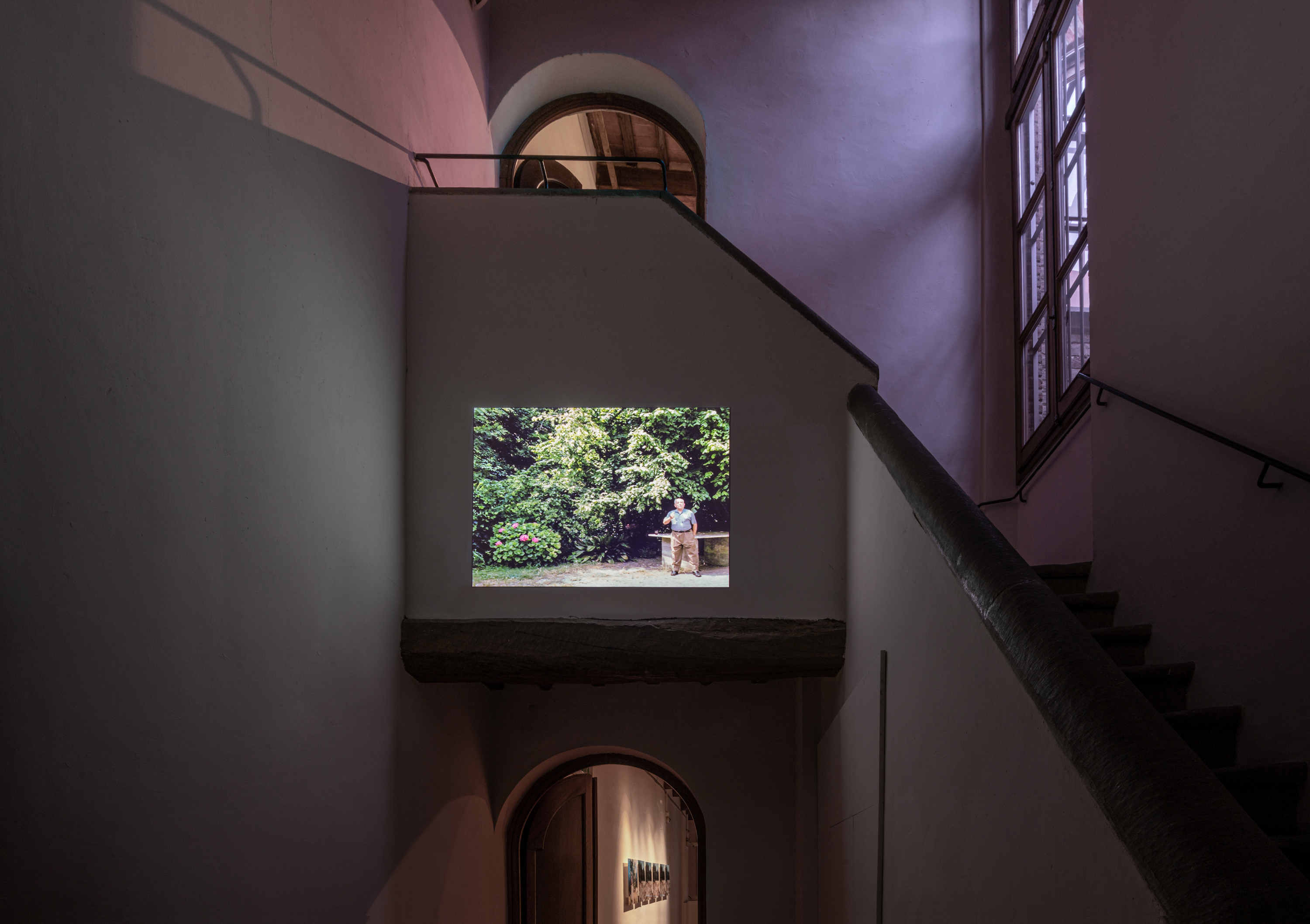ANTHOLOGY
CHAPTER I
The Green and the Stone
Curated by Rita Selvaggio
The Remains of the Day (2014) · Shinzaggaran (2014) · Allotropes (2016) · Anime (2019) · Jean-Marie Straub e Danièle Huillet. Film e loro Siti (2020-2021) · While We Were Sleeping (2021) · The Green and the Stone. Straub-Huillet in Buti, un film di Armin Linke in collaborazione con Rinaldo Censi, Giulia Bruno and Giuseppe Ielasi (2017).

Jean-Marie Straub e Danièle Huillet. Film e loro siti. Installation view. Ph. Ela Bialkowska, OKNOStudio,
Courtesy Casa Masaccio | Centro per l’Arte Contemporanea.
From 4 June to 16 October, Casa Masaccio | Centro per l’Arte Contemporanea is hosting Anthology, the first chapter in a sort of catalogue laid out in space that lets itself be leafed through, page after page, in the rooms of the museum and that presents, through films, documents and documentaries, testimonies from the archives, models, modes and traces, some episodes from the recent history of the ‘Casa’. Very often, acts and works lead back to fossils of other acts and other narratives, providing, within this initial selection, connections and conversations.
The premises are those of The Remains of the Day, which opened on the evening of Saturday 21 June in 2014, the day of the summer solstice; an exhibition in which the practice of twenty or so artists (Alessandro Agudio, Marco Basta, Lupo Borgonovo, Cleo Fariselli, Dario Guccio, Helena Hladilova, Invernomuto, Andrea Kvas, Alice Mandelli, Beatrice Marchi, Anna Mostosi, Gianni Politi, Lisa Rampilli, Giangiacomo Rossetti, Manuel Scano, Namsal Siedlecki, Davide Stucchi, Serena Vestrucci), young at the time, took a multidisciplinary approach to the investigation of possible new syntaxes and the deposits left by time with respect to a performative action and/or happening. The remains of that long day were set out along a route that, winding through several venues, raised questions about the display of exhibition and presented works that were fragmentary, participatory or in progress. Among them was Shinzaggaran, named after a bloody battle that took place in 1871 between the Kel Denneg and Kel Gers, nomad Tuareg tribes for whom the time of myths is not that of the epic but exists solely in the incessant fluidity of experience and the natural integration of the past with the present. The exhibition filled Casa Masaccio completely, encouraging visitors to choreograph their own presence. Among the interventions, all conceived specially for the occasion, Concert for Caballeros (2014) by Beatrice Marchi, a performance that by including singers and storytellers as well as a kitten, turned the staging into a sort of ephemeral backdrop. Digital sounds that imitated the harpsichord, strings, sitar and harp to the hip-hop rhythm of an atmosphere that summoned the witches and ghosts of the town to dance.
Hill of Dreams (2016), part of Allotropes (2016), a solo exhibition by Jessica Warboys, is a film commissioned by Casa Masaccio with Tate St Ives (UK) and Kunsthall Stavanger (N) that took its inspiration from the novel of the same name by the writer Arthur Machen (1863-1947) published in 1907. In part a mystical exploration of and commentary on a materialistic society, and in part autobiography, it tells the story of the journey of an aesthete and dreamer to another reality and a pagan world before losing himself in the nature surrounding the small town of Caerleon in rural Wales. The exhibition, and the story, continues with the documentary film of While We Were Sleeping, the solo exhibition by Lewis Hammond held in 2021. Here the intensity of an intimacy hidden in the endless potentialities of the representation of the real and an encrypted narration are punctuated by large fields of green that, notwithstanding its artificiality, alludes metaphorically to the Scenes from Genesis. This cycle of frescoes painted by Paolo Uccello in the cloister of Santa Maria Novella in Florence was executed for the most part in a monochrome verdeterra or, as the Dominican friar Vincenzo Borghigiani put it in the 18th century, “in a juice of grasses and green earth”.
The first chapter of this anthology also includes a focus on the pair of filmmakers Jean-Marie Straub and Danièle Huillet, recipients of the 13th/14th iteration of the Premio Marco Melani and guests of Casa Masaccio with Films and Their Sites, an exhibition to which the next online programme of Esporre il cinema will also be devoted. In addition to the introduction by Enrico Ghezzi, director of the award, and library footage, the focus hosts The Green and the Stone. Straub-Huillet in Buti (2017) a film made by Armin Linke, in collaboration with Rinaldo Censi, Giulia Bruno and Giuseppe Ielasi, at the Teatro Francesco di Bartolo in Buti, in the Tuscan countryside, where the two French filmmakers had found creative hospitality. The film was commissioned on the occasion of the exhibition Tell It to the Stones: The Work of Danièle Huillet and Jean-Marie Straub (14 Sep 2017-19 Nov 2017) at the Akademie der Künste in Berlin and tells of their theatrical vocation; an inclination that shapes their use of scripts and their proudly independent cinema devoid of spectacular frills, as well as their handling of the camera, with panoramic takes of natural settings, aimed at a point of light that is promise and destiny.
This first chapter of Anthology ends with Giulia Piscitelli’s Disarmo (2019). Commissioned to coincide with Anime, her solo exhibition of the same year, it has proved today to be a warning as prophetic as it is topical. In the video, in a single take that tolerates no superimpositions, the strong hands of Yuriy Onishchuk, a Ukrainian from Zhmerynka, destroy a weapon with a flexible shaft grinder, turning it into inoffensive dust.
